OTHER RESOURCES
Very readable volumes about the Grand Central Air Terminal are these books:
Underwood, John. 1984. Madcaps, Millionaires and 'Mose'. Heritage Press, Glendale, CA. 144pp.
And...
Underwood, John. 2007. Grand Central Air Terminal. Arcadia Publishing. Charleston, SC. 127pp.
---o0o---
Thanks to Guest Editor Bob Woodling for help researching this page.
---o0o---
YOU CAN HELP
I'm looking for information and photographs of this airplane to include on this page. If you have some you'd like to share, please click this FORM to contact me.
---o0o---
SPONSORED LINKS
HELP KEEP THESE WEB SITES ONLINE
FOR YOUR CONVENIENCE
You may NOW donate via PAYPAL by clicking the "Donate" icon below and using your credit card. You may use your card or your PAYPAL account. You are not required to have a PAYPAL account to donate.
When your donation clears the PAYPAL system, a certified receipt from Delta Mike Airfield, Inc. will be emailed to you for your tax purposes.
---o0o---
TROJAN FLYING CLUB
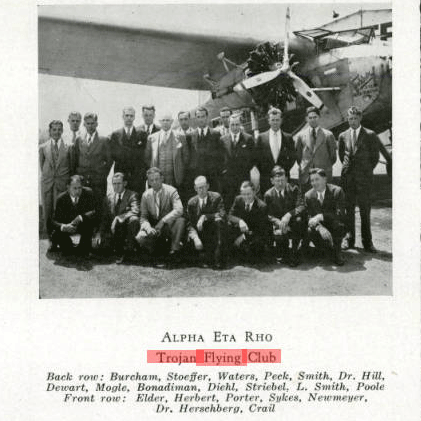 |
According to the link, the Trojan Flying Club, Ltd. was founded as a limited liability company in California on July 17, 1931. It was apparently active for a year or two earlier, given the dates of the photograph at right and the solicitation for membership, below. Regardless, it was a student-populated club at the University of Southern California (USC). The students learned to fly from local and federal instructors. Non-students were also members, and they used the Club's aircraft for business and other functions.
Club members in 1929 (before incorporation?) were captured in front of an unidentified Fokker tri-motor, right. This photograph is from the USC yearbook for 1929. None of the people in the photograph appear to be signed in the Grand Central Air Terminal (GCAT) Register. Two names, Burcham (Milo) and Porter (Robert), are familiar to us from other Registers, but as far as I know neither of them were USC students or members of the Club and they are not the individuals pictured. The Trojan Flying Club was the actual flying unit of the USC fraternity, Alpha Eta Rho (AER). AER was founded at the University of California.
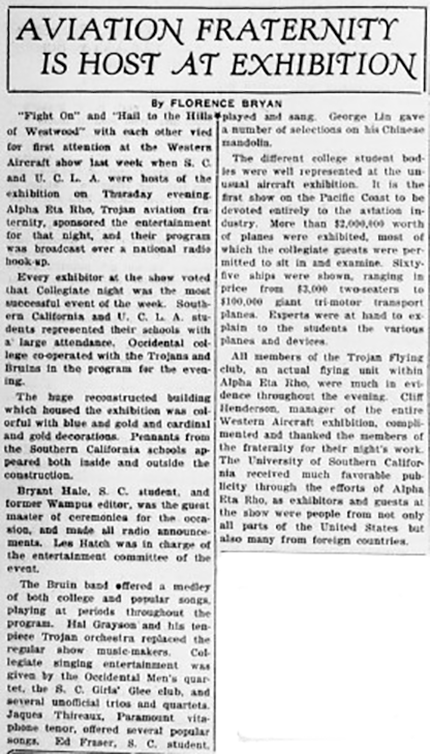 |
The school newspaper, the Southern California Daily Trojan of November 22, 1929 reported on a large aviation conference hosted by the USC Trojans and other area flying clubs, right.
For historic context, it was two years after Charles Lindbergh's trans-Atlantic flight. Aviation was a hot topic in the U.S. and in other countries. Individuals, clubs and local governments across the U.S. proliferated flying. The demand for aviation services resulted in an explosion of airfields and facilities (fuel, hangars, navigation aids) development. The Trojan Flying Club was one example.
The article notes it was the first show of its type on the Pacific coast, entirely devoted to aviation. It included a social component as well as an exhibition of contemporary aircraft and hardware. There is no mention of a flying exhibition, although I can't imagine that flying activities were not part of the event sometime during the weekend.
New Club members were activiely solicited, as indicated in this advertisement from the Daily Trojan, below.
 |
There were twenty-seven landings recorded by tower Operators A.J. Lygum, "Roscoe" and "Wright" that cited the aircraft owner as "Trojan Flying Club" (if anyone can identify Roscoe or Wright, please let me KNOW). Each landing was flown in the same airplane, the Timm C-165 Collegiate, S/N 102, identified as NC887E.
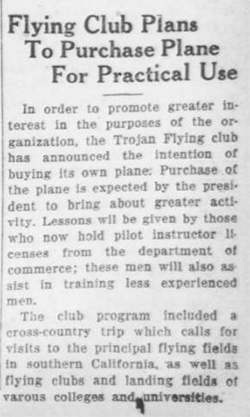 |
Besides the 27 landings recorded where the Club was cited as aircraft owner, the Timm was recorded two other times in theGCAT Register, once (Sunday, 3/22/1931) when the owner was not identified, and once (Saturday, 4/18/1931) where the owner was identified as the Shell Oil Company. I think the owner in the latter case was misidentified, since the airplane was sited as owned by the Club in the search & rescue article from 1932 just below.
Collegiate Flying Clubs To Compete With a special feature exhibition of aerial acrobatics, the first Pacific Coast intercollegiate air meet ever held is scheduled at the Palo Alto airport tomorrow afternoon at 1 o'clock. Teams will compete from Stanford, U.S.C., U.C.L.A., California, and San Jose State. Events in the competition will include "spot" landings, "bomb" dropping, and balloon bursting. Scoring will be in accord with the rules of the National Intercollegiate Flying Association, and will be conducted on the same basis as the scoring of a track meet. Ability Needed Co-ed to Compete |
Despite the training activity with Trojan Club members, the Timm was not the airplane described in the news article,right, which announced the Club's intention to purchase an aircraft for "practical use" during October, 1932.
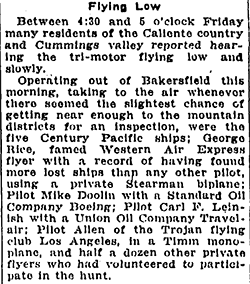 |
However, the Timm was clearly identified in an excerpt from another article from the Bakersfield Californian of Monday, February 1, 1932, right. On Friday, January 29th, a Century Pacific airliner disappeared in snow-bound mountains southwest of Bakersfield. The article states that "Pilot Allen" of the Trojan Flying Club flew the Timm in a search and rescue attempt over the weekend. Other Register pilots were cited in this paragraph exerpted from the longer article headlined," Believe Lost Flyers Still Alive." They were George Rice, Mike Doolin and Carl Leinesh. I do not know if "Pilot Allen" was "Charles Allen" who was recorded in the GCAT Register flying a Command-Aire, NC477E, on January 1, 1931.
 |
We can pinpoint the approximate date of the Club's acquisition of the Timm. There was an article in the Daily Trojan, February 18, 1930 that specifically cited plans to acquire it. That article is exhibited at Register pilot Victor M. "Rex" Rechtsteiner's Web page at the link.
Of the 27 landings, pilots were identified and cited only three times. Clarence "Ace" Bragunier was recorded twice and the third pilot was identified simply as "Rex," who turns out to be Victor Rechtsteiner, linked above.
Regardless, all the landings were by the Timm were recorded between December, 1930 and July, 1931. Bragunier was an experienced pilot and could well have been an instructor in the USC flight training program. Most of the times on the ground by the airplane were less than 1/2 hour before departing, suggesting student training activity.
In 1938, a special air meet was held that included the Trojan Flying Club. The Stanford Daily of April 15, 1938, left, reported the event. I do not know what happened to the Club as WWII approached, but with the limits placed on civil flying, especially near the coasts during the war, its members probably saw little activity. It's a good bet that many of the pilots were put to use in military flying.
It is clear that the Club resumed activites after WWII. Well after the war, the Trojan Club sponsored its own air meet in 1953. Another article from the Daily Trojan of April 22, 1953, right documented the meet and the activities. The newspaper was torn at the upper left part of the column.
Another article, below, right, from April 24, 1953 summarized the activities at left and added a few late changes.
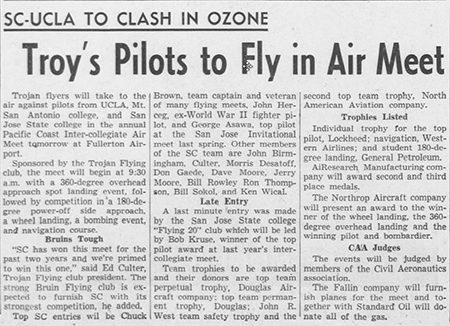 |
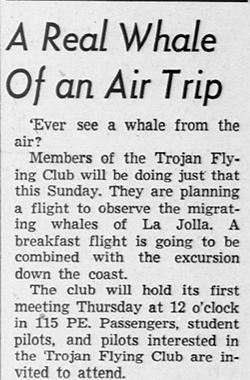 |
The following year, besides aerial competition and search & rescue, the Club added sightseeing to its activities. The article, left, from the Daily Trojan of February 10, 1954 described a whale watching experience from the air. I have no record of what aircraft the Club flew during the 1950s.
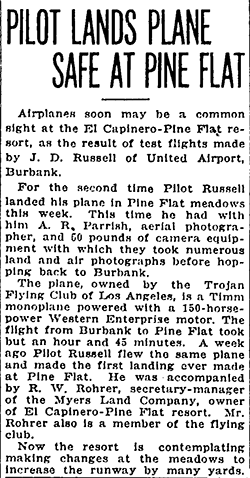 |
Casual mentions of the Club appeared in various newspapers over the years. One from the Bakersfield Californian of July 23, 1931 is at right and mentions the Timm. In this case, the Timm was used for aerial and ground photography, seemingly in support of real estate interests.
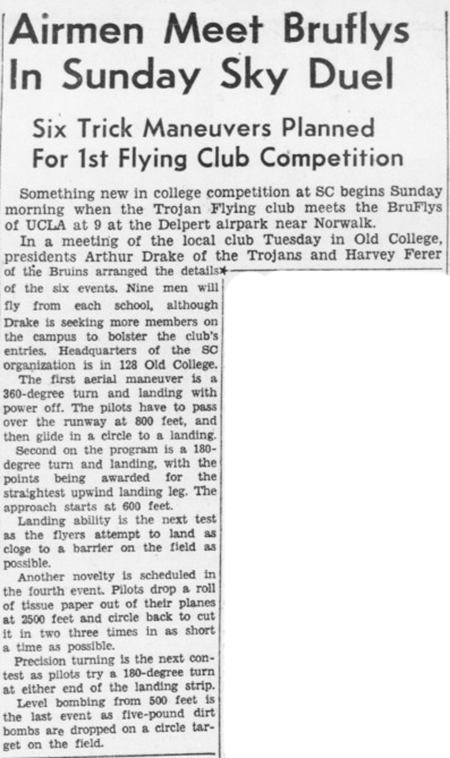 |
Air meet activities returned to the Club after WWII. The Daily Trojan, May 14, 1948, left, documented a meet, which included traditional aerial contests like cutting toilet paper streamers, dead stick landing and bomb drops. This meet does not sound as grand as the one organized in 1929 described above.
According to the link, the Trojan Flying Club, Ltd. was suspended (date unknown), and it is inactive. The articles cited on this page show that it was active into at least the 1950s. If you can help fill in the blanks, please let me KNOW.
---o0o---
SPONSORED LINKS
THIS PAGE UPLOADED: 02/23/16 REVISED: 03/10/16
